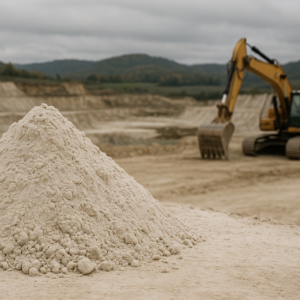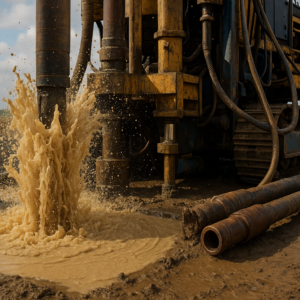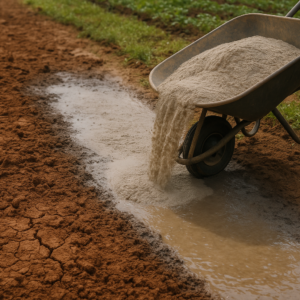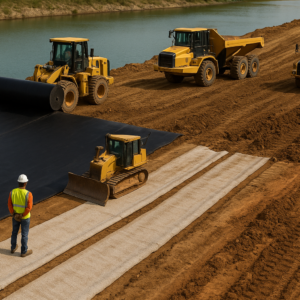Do you own a fun and relaxing pond? Surrounded by beautiful plants and decorative stone-laden pathways, ponds can add life to your backyard or front lawn. For those considering creating such a serene environment, using bentonite for pond construction is essential. It ensures that your pond retains water effectively and remains a peaceful haven where nature and homeowners/guests coexist.
Although having your fish pond can be wonderful, it can quickly turn into a migraine-inducing ordeal if it starts to spill or leak. If you find yourself constantly refilling your pond or notice that the surrounding area is soft, damp, or partially submerged, you likely leak your pond.
Similarly, ponds can be a menace in case there is a leak in the pond made for the use of the community. The proper sealant can be a godsend for all your pond leakage problems.
Why Do Ponds Start To Leak?
It is common for your pond to lose water to evaporation in the summer. During severe heat waves, your pond’s water level might drop several centimeters daily. It is also common for newly constructed ponds to have some leakage. But if your pond consistently loses copious amounts of water, you must find the underlying cause.
Here are some reasons why you have a leaky pond:
- Poor site selection
- Erosion of the pond liner
- Holes/cracks in the liner
- Failure in pond repairs
- Poor pond construction
- Plumbing issues
- Presence of the wrong plants
- Damage from burrowing animals
Selecting a poor site is often the result of insufficient preliminary site checks and is an easily avoidable situation. You can avoid improper construction just as you can avoid the growth of trees and shrubs that develop root systems that undermine the dam.
Sometimes, a poor site has to be used for ponds if there is no other choice and there is a dire need for water. If so, the original pond design must include plans for reducing seepage by sealing the pond bottom.
To prevent excessive seepage, reduce the permeability of the soil to a point at which losses are insignificant or tolerable. The method depends mainly on the soil’s coarse-grained sand, gravel, fine-grained clay, and silt proportions. Finding pond leakage issues can take time and effort. Many of these issues can be fixed, but it’s crucial to see them before you can start reparation work.
Why Is Pond Sealing So Important?
Before we dive into the details, we must answer this critical question: Why is pond sealing so important? Imagine filling a new pond with fresh water and then seeing it dry within a few weeks. A pond that leaks again and again is super frustrating for the owner. Pond sealing is a science; if you do not follow it, you must follow it to save your investment and pond.
Pond sealing helps ensure that your pond stays impervious. It helps to stop leaks, avoid water wastage, and keep the pond’s water level right. It can help to prevent damaging the delicate ecosystem of your pond, help conserve water resources, and avoid harming surrounding areas.
The tedious and challenging job of sealing a pond can be time-consuming and expensive. There are different drawbacks to using a joint sealant for pond sealing. One of the critical reasons why pond sealing is so essential is water life security because the pond will probably be full of water and algae or plant growth, which a leakage in the pond can harm.
Also Read: – Geosynthetic clay liner uses
Why Use Bentonite For Pond Construction
Sodium Bentonite is also known as “high-swell” clay. Its remarkable qualities make it greatly useful in sealing ponds and withholding water for the most extended period.
Bentonite changes from a powder to a muddy gel when mixed with water. This gel fills the cracks and pores in the pond floor, creating a natural and very resistant barrier to keep the water in the pond.
You can use Bentonite to seal dry or full ponds, even in ponds with plants and fish. It is volcanic ash, which is a 100% natural earth material that does not involve other chemicals or hazardous substances. It does not contaminate the water. It is eco-friendly and safe for fish, plants, stock, and swimming.
Bentonite pond sealer, a natural clay product, chemically attracts to itself and swells up to 12 times its dry size when moistened. It also makes an excellent liner for new pond construction.
Sodium Bentonite can help your pond retain water levels and significantly reduce the water seepage rate. It has the property of quick adsorption. It is a cost-efficient pond sealing element.
It is naturally erosion-resistant and lasts for an extended period. With re-swelling nature and re-hydration, particles quickly disperse in water and obtain high absorbency. The bentonite pond sealing should be applied evenly across the soil using a seed or fertilizer spreader.
How to Apply Bentonite for Pond Construction
There are three different methods of using bentonite for pond sealing. They are as follows:
The Blanket Method:
This is one of the most successful and popular methods. However, the pond must still be under construction and unfilled for this method to be applied. In the case of using this method on an already constructed pond, it has to be emptied and dried out.
The next step is to remove any rocks, vegetation, and trash from the bottom of the pond. Then, remove 4 to 6 inches of the soil from the pond bottom. In the next step, find any holes or crevices and fill them with a mix of five parts soil to one part Bentonite. Then, the area needs to be smoothed using a roller.
The required amount of Sodium Bentonite is then evenly spread on the area, ensuring no thin or bare spots. This ensures complete coverage and proper sealing. After this, carefully spread the 4 to 6 inches of soil removed earlier over the bentonite layer while ensuring not to disturb the bentonite layer. Finally, the soil is compacted by using a roller or temping plate.
You can wait some days for the bentonite to swell before filling the pond with water again. But you can fill it out immediately if you want to. Just ensure you are using a gentle water flow to avoid erosion of the soil and bentonite layers.
The Mixed Blanket Method:
The mixed blanket method is similar to the blanket method. The key difference here is that a layer of a mix of Bentonite and soil is used instead of only Bentonite. The first step is ensuring the pond is empty and sufficiently dried out.
The next step is removing debris, vegetation, and rocks from the pond bottom. Check the pond bottom for any holes, cracks, or crevices and fill them with a mixture of one part Bentonite to 5 parts soil.
Next, plow, till, or disc the top 4 to 12 inches of soil. Then, using a fertilizer or seed spreader, the required amount of sodium bentonite is applied to the soil in an even layer. Mix the Bentonite with the top 4 to 6 inches of soil by discing, tilling, or hand raking while ensuring no bald spots are left. Multiple passes over the area are recommended.
I am finally, a roller compact is used to compact this mix of bentonite and soil. WaterWater might be added to ensure complete compaction if the soil is too dry. Be careful when adding water back to the pond. Use gentle water flow to prevent disturbing the bentonite-soil mix.
The Sprinkle Method:
In the following scenarios, the sprinkle method can be used for pond sealing:
- Emptying or draining a pond entirely is not possible or not feasible.
- Leaks are relatively minor and are isolated from each other.
- Leaks need to be fixed quickly.
This method is less efficient than the blanket or mixed blanket methods. This is due to difficulties in uniform and accurate placement of the bentonite, and the pond bottom may include debris such as trash, vegetation, logs, rocks, etc., which may prevent sufficient coverage.
Start by clearing out the pond bottom of any logs, vegetation, or rocks to increase the chances of success of the sprinkler method. Then, sprinkle the required amount of sodium bentonite on the surface of the pond water and let it fall to the bottom.
The bentonite particles will reach the bottom and swell to fix the leaks. You will require more sodium bentonite than the other two methods. Sodium Bentonite will cause cloudiness in the pond water, but it will be cleared within a few days.
Why Use CMS SEAL?
At CMS, we bring you top-quality bentonite material in a quantity that suits your needs. The following are a variety of characteristics that make this such a great solution to all your leaky pool issues:
- Eco-friendly
- Quick adsorption
- Cost-efficient
- Reduction of water pollution
- Strong, impermeable layer that prevents leaks
- Purifies water
- Safe for aquatic animals and vegetation
- Seals the lower bed of the soil to reduce seepage
- It is convenient to mix because of its dispersed nature
To learn more about how sodium bentonite can help with your leaking pond, visit us at www.cmsindustries.in or fill out this form stating your need for an instant quote.







